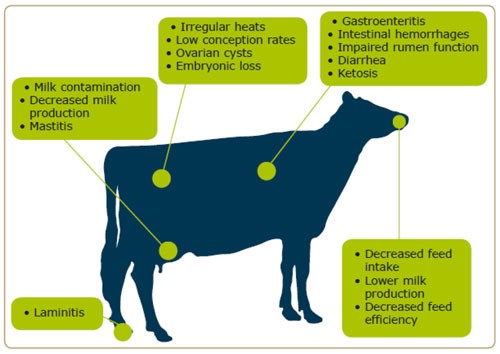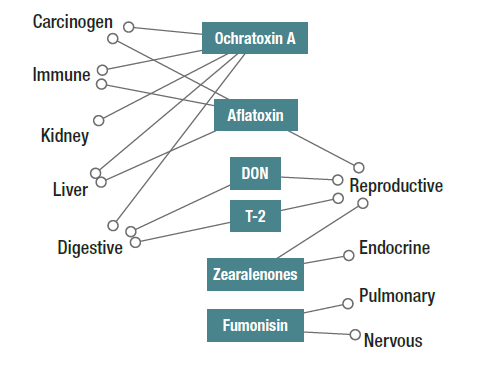Mycotoxins – A Forgotten Issue?
Is your herd suffering from a larger than normal mycotoxin burden this autumn?
Several silage pits that I have inspected this autumn on farms, have shown heating and mould growth. This was just on the face. How far back does it go?
These warm favourable growing conditions this autumn, may not be helping with the increased mycotoxin load. Hopefully if we get a real cold spell then it will significantly reduce the growth.
The obvious signs of mycotoxins are moulds growing on the silage face. I’ve seen white, red, orange and blue moulds, and be they good or bad, they will still affect the rumen and therefore cow health, fertility and production.
 One of the more obvious signs is a loss of production, but you can also see signs such as swollen hocks, swollen ends to the cow’s teats and diarrhoea. They can also lead to the loss of pregnancy and affect fertility on farm. The list of symptoms can be long and varied.
One of the more obvious signs is a loss of production, but you can also see signs such as swollen hocks, swollen ends to the cow’s teats and diarrhoea. They can also lead to the loss of pregnancy and affect fertility on farm. The list of symptoms can be long and varied.
Image right - Overview of the main health effects of the most frequently observed mycotoxins (adapted from Gabler, 2015)
 The farms I’ve seen it on are typically feeding second cut grass silage, to save first cut for the winter period. This silage will be drier than first cut and may not have consolidated as well which would allow more air into the silage allowing for more mould growth.
The farms I’ve seen it on are typically feeding second cut grass silage, to save first cut for the winter period. This silage will be drier than first cut and may not have consolidated as well which would allow more air into the silage allowing for more mould growth.
If you think you have a problem you can test your feed, or the quicker and no more expensive option, would be to feed a mycotoxin binder for a month and see if you notice a difference. You should see a response within a few days.
Imageabove- Different Mycotoxin spores’ effect different areas of the body as seen below.
If you have concerns or your cows are not performing as expected, contact Mark at markyearsley@fcgagric.com or your local FCG Office on this or any other feeding issues.

Recent Articles
- Do You Know the Benefits of a Health and Heat Detection System?
- Have you Ordered Your Silage Inoculant?
- Growing More Grass With Less Nitrogen, Where Do I start?
- A Real Recognition of The Importance of Food Security or Simply A Reconciling of DEFRA Budgets?
- Silage Sheet Prices Available!
- Are Your Cows at Risk of Grass Staggers?
- Feed Late Afternoon and Calve in Daylight Hours!
- Q Fever
- Aerating Your Soil Without A Machine? – Gerard Finnan
- Why Are You Not doing a Soil Management Plan?

